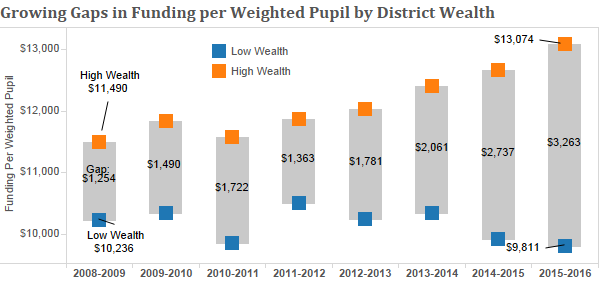GOVERNOR CHRISTIE’S UNFAIR SCHOOL FUNDING PLAN: PART II
THE RIGHT WAY TO CALCULATE – AND COMPARE- DISTRICT FUNDING
The Governor is adept at manipulating the calculation of “per pupil” spending to serve his political agenda. He uses “total spending per pupil” as a way to falsely claim that high need districts spend excessively. The New Jersey Department of Education’s (NJDOE) “budgetary cost per pupil” is a better calculation because it focuses on actual spending to educate current students enrolled in any given district. But it does not account for differences in student need among districts. The most accurate way to compare resources in NJ districts is using a calculation – “funding per weighted pupil” – that acknowledges that the cost of educating students is not the same, but varies based on the characteristics of a district’s enrollment. To see a district by district comparison of these measures, click here.
The concept is simple and universally accepted in education finance: children at risk from family and community poverty, those who are learning English, and students with disabilities need additional supports and interventions, and districts need additional funds to pay for them. This principle is the cornerstone of NJ’s school funding formula – the School Funding Reform Act (SFRA).
For at-risk students to succeed, districts must hire additional staff, such as literacy and math specialists, bilingual/ESL teachers, and special education specialists. Districts serving more students with special needs have higher costs than districts with fewer of these students. Spending comparisons are inaccurate and incomplete if they are not adjusted to account for the differences in student need, district by district.
The “funding per weighted pupil” measure makes this crucial adjustment by using the “weights” set in the SFRA funding formula. These “weights” represent the additional per pupil costs in the formula for at-risk (low-income), English language learner (ELL), and special education students. Without adjusting for student need, the 100 districts with the highest funding per pupil are spread across the state, with 17 in low wealth districts, 51 in middle, and 29 in high wealth.
When calculated by weighted per pupil funding, 44 of the top 100 districts are high wealth, and only four are low wealth. In fact, far from having “extravagant” funding as the Governor claims, 26 of the former Abbotts are in the bottom half of districts in the state when ranked by weighted per pupil funding. So the Governor’s narrative is false: the districts with the highest revenues are far more likely to be middle or high wealth, spending a healthy amount to educate a less costly student population with far less need than in low wealth districts.
Growing Inequity under Governor Christie
The funding per weighted pupil measure shows how dramatically funding inequity has increased under Governor Christie’s tenure. Using this measure, high wealth districts receive an average of $13,074 in revenue for a student with no special needs, and low wealth districts are left with only $9,811 after accounting for the extra costs required for low-income, ELL, and special education students.
Weighted per pupil funding increased by 14% in high wealth districts between 2008 and 2016, thanks largely to a 17% increase in local revenues. Low wealth districts have raised local revenues at a similar rate (16%), but because local funding is a smaller share of total funding those increases don’t generate a comparable overall increase.
Due to growing enrollments, a needier student population, and largely flat state aid, weighted per pupil funding in low wealth districts actually declined by 4% in this same period. After seven years in which the Governor did not fund the SFRA formula, the gap in weighted per pupil funding between high and low wealth districts has grown from a $1,254 advantage in wealthy districts in 2009, to $3,263 in 2016. If the Governor’s flat state aid plan were to be implemented, the inequity would climb to unimaginable levels.
Given the very high levels of student need in NJ’s low wealth districts – coupled with the Governor’s refusal to properly fund the SFRA since he came into office in 2010 – teachers, support staff and other essential resources are eroding in many low wealth districts. Despite what the Governor may say, money does matter, and the highest wealth districts, including his own hometown, consistently show that it matters as they continue to raise local revenues and outspend their less affluent peers by even greater margins. Instead of scapegoating our highest need districts for a property tax burden the Governor has caused himself by not funding the SFRA formula, it’s time for all New Jerseyans to stay focused on improving educational opportunity for all students across our state.
Visit this ELC web page to view state and district summaries of The Right Way to Compare NJ Education Funding, including historical data.
Related Stories:
PART I: THE GOVERNOR IS WRONG ON HOW MUCH DISTRICTS SPEND
Press Contact:
Sharon Krengel
Policy and Outreach Director
skrengel@edlawcenter.org
973-624-1815, x 24
Press Contact:
Sharon Krengel
Director of Policy, Strategic Partnerships and Communications
skrengel@edlawcenter.org
973-624-1815, x240

